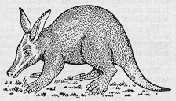
 aard·vark (ärd'-värk´),
n. A burrowing mammal, Orycteropus afer, of southern
Africa, having a stocky, hairy body, large ears, a long tubular snout,
and powerful digging claws. [Obsolete Afrikaans, "earth-pig" :
aarde, earth, from Dutch, from Middle Dutch aerde +
vark, pig, from Middle Dutch varken.]
aard·vark (ärd'-värk´),
n. A burrowing mammal, Orycteropus afer, of southern
Africa, having a stocky, hairy body, large ears, a long tubular snout,
and powerful digging claws. [Obsolete Afrikaans, "earth-pig" :
aarde, earth, from Dutch, from Middle Dutch aerde +
vark, pig, from Middle Dutch varken.]
All by itself, this peculiar termite-eating mammal constitutes the order Tubulidentata, and the family Orycteropodidae. Why, the reader may ask, does it stand so isolated from other mammals? The reason is the the anatomical structure is quite unlike any other mammal, and gives no indication of the group in which it should be placed. The teeth are simple cylinders of dentine traversed from base to crown by hundreds of minute passages, or tubules. It has no immediate ancestors but probably stems from very early ungulates, as did the hyraxes.
Subclass EUTHERIA
Order TUBULIDENTATA
tubus (L) a pipe, tube; -ulus (L) diminutive suffix;
dens (L), genitive dentis, a tooth -atus (L)
suffix meaning provided with (see introductory note above).
Family ORYCTERPODIDAE 1 species
orukt¯er (Gr) a tool for digging; pous (Gr), genitive
podos, a foot.
Aardvark Orycteropus afer
'One that has feet for digging'; it has powerful claws and is a
remarkably fast digger Afer (L) African. Aardvark was originally
South African Dutch, now known as Afrikaans, for earth-pig. Though
rarely seen, being nocturnal, it is widespread in Africa south of the Sahara.
The F-111 Aardvark fighter-bomber was the first swing-wing
combat aircraft to enter service. Built by General Dynamics, the original
prototype first flew in December 1964. The F-111A was a two-seat aircraft
powered by two 18,500 lb st Pratt & Whitney TF30-P-3 afterburner turbofans
and armed with a 20-mm M61A1 rotary cannon, designed for long-range,
deep-penetration runs, against either ground or air targets. It had an
internal bomb bay and eight external wing stations for ordnance.

There were several other production models of the F-111. The F-111B was a ship-based design built by Grumman that never made it into the production stage, due to being too heavy for carrier use. Twenty-four F-111C's were built for the RAAF; they possessed a longer wing-span than the F-111A, but were otherwise identical. The F-111D flew on 20,840 lb st TF30-P-9 turbofans, and featured updated avionics. The F-111E was identical to the F-111A, except for refined air-intakes. The final production model of this aircraft was the F-111F, which included all of the airframe changes made on the preceding models (such as the longer wing-span of the F-111C), simpler yet more advanced avionics, and two 25,100 lb st TF30-P-100 turbofans; it also added the Pave Tack infrared target acquisition and laser designation pod, which allwed the F-111F to attack both day and night targets using laser-guided missiles. There were two other variants of the F-111; the EF-111A Raven, which featured a tactical electronic counter-measures jammer and had no offensive weapons, and the FB-111A fighter-bomber, which had the wing-span of the F-111C and was used by the USAF Tactical Air Command. In 1990-91, the USAF redesignated the remaining FB-111As as F-111Gs and upgraded the engines to 20,350 lb st TF-30-P-7 turbofans.
The Aardvark first saw action in Vietnam. Once the design flaws were ironed out, it gained a reputation as one of the most versatile and reliable aircraft around. It could carry any weapon in the U.S. Air Force with the exception of the very largest bombs, and so could be easily configured for whatever mission was required of it. The F-111 gained some public renown in 1985 when it was used for the bombing of Libya in retaliation for Libya's support of certain terrorists. The F-111E, F-111F, and EF-111A saw major action in the Persian Gulf War, flying a total 3,986 sorties and only losing a single EF-111 Raven. Forty-six percent of the laser-guided bomb strikes in the Gulf War were delivered by F-111s. The Aardvark was the only fighter in the Gulf War to utilize the GBU-15 infrared-guided bomb, and it was an Aardvark which dropped a 4,700-pound GBU-28 laser-guided bomb on the North Taji command bunker on the last day of the war.
After the Persian Gulf War, the F-111 Aardvark was retired by the USAF and all of the remaining F-111s in the United States were scrapped.
Technical data for the F-111F, unless otherwise noted:
Max. speed: 1,453 mph at 52,700 ft (Mach 1.38), and 914 mph at sea level
(Mach 1.2)
Combat climb: 43,050 ft/min
Combat radius (HI-LO-HI): 1,242 mls
Empty weight: 47,481 lb
Max loaded weight: 100,000 lb
Span (swept) 31 ft, 11 3/4 in; (extended) 63 ft, 0 in
F-111C/FB-111A Span (extended): 70 ft
Length: 75 ft, 6 1/2 in
Height: 17 ft 0 1/2 in
Wing area: 525 sq ft
Armament: one 20-mm M61A1 multibarrel rotary cannon; internal bomb bay;
six-eight external under-wing pylons for further ordnance
Return to Aardy's home page.